A Bibliometric and Visual Analysis of Global Community Resilience Research
Abstract
1. Introduction
2. Methodology and Data Acquisition
2.1. Methodology
2.2. Data Acquisition
3. Distribution Characteristics of Community Resilience Research
3.1. Temporal Distribution of Community Resilience Research
3.2. Macro Global Geographic Distribution of Community Resilience Research
3.2.1. Distribution of Countries/Regions
3.2.2. Distribution of Institutions
3.3. Distribution Characteristics of the Micro-Knowledge Network of Community Resilience Research
3.3.1. Distribution of Categories
3.3.2. Distribution of Co-Citation Journals
3.3.3. Distribution of Author Collaboration
4. Intellectual Bases and Hotspots of Community Resilience
4.1. Intellectual Bases of Community Resilience
4.2. Research Hotspots of Community Resilience
5. Conclusions
- Community resilience research has gone through the initial stage, slow development stage, and rapid growth stage in terms of publications. After 2010, literature on community resilience began to increase gradually. Especially after 2013, the number of published papers has achieved rapid growth. In 2020, the rate reached 475 papers/year.
- From the perspective of macro-geographical distribution, the United States, Australia, and the United Kingdom have made the most contributions to community resilience research. The global geographic heat map shows that North America, Oceania, Europe, and Asia are hot spots for community resilience research, while most South American and African countries still need to strengthen their output. In terms of institutional distribution, Colorado State University and Texas A&M University are the most influential institutions in community resilience research.
- From the perspective of the micro-knowledge distribution characteristics, the categories of ecological environment, water resources, and geography are the subject areas with the largest proportions in interdisciplinary resilience research. Global Environmental Change—Human and Policy Dimensions is the most widely researched journal in community resilience research. The most prolific author is John W. van de Lindt. Although some core authors do not publish the most articles, their theories or research have significantly impacted the development of community resilience, such as Cutter S.L. and Norris F.H.
- Through literature co-citation analysis and high-frequency keyword clustering analysis, this study revealed the intellectual bases and research hotspots in community resilience research. Community resilience research is mainly divided into the following seven sections: social capital mechanism, evolution of resilience knowledge, earthquake resistance and disaster mitigation, substance abuse group research, rural community resilience development, resilience-building in the least-developed countries, and emergency preparedness. The seven sections form the intellectual basis of community resilience research. The cluster analysis of high-frequency keywords obtains nine clusters. Through further merger and integration, five research hotspots in the community resilience field were revealed, including the concept of resilience, climate resilience, social capital mechanism, macro-environment, and community disaster-reduction policies, and an evaluation index system of community resilience.
- Focusing on future development, community resilience research will continue to conduct more in-depth research in hotspots and fronts fields. First, in terms of resilience assessment, more raw data and publicly available secondary data will be explored to consummate the concept and corresponding mechanism, and the needs and priorities of different communities will be focused on to improve the community resilience assessment system. Thus, comprehensive resilience assessment frameworks and methods will be further integrated. Second, social capital continues to be the central mechanism of community resilience research, and its significance and measures will be further expanded. Third, the research on the intervention factors of the psychological resilience of special groups and their behaviors may be transferred to new groups. Fourth, global projects will sustain the use of community interventions to advance community resilience practices and enhance the resilience of communities to combat major risks. Fifth, with the emergence of new natural disasters and man-made disasters, communities will play a vital role in coping with total disasters in the future. Therefore, exploring the construction of the community resilience field in total disasters is also one of the possible directions for breakthroughs in the future.
- However, there are certainly several limitations to this study that need to be acknowledged. Bibliometric analysis can bring about some interesting clustering results in terms of authors, locations, and themes. Intellectual bases and hotspots of community resilience were also analyzed based on the bibliometric analysis in Section 4. Unfortunately, bibliometric studies are still not as in-depth as traditional literature reviews. Furthermore, the keywords may be partially useful in the bibliometric analysis because there are some common phraseologies around the general theme of resilience. Therefore, the author’s understanding of the scientific field should be added based on bibliometrics.
Author Contributions
Funding
Data Availability Statement
Conflicts of Interest
References
- Hosseini, S.; Barker, K.; Ramirez-Marquez, J.E. A review of definitions and measures of system resilience. Reliab. Eng. Syst. Saf. 2016, 145, 47–61. [Google Scholar] [CrossRef]
- Xu, H.; Li, Y.; Tan, Y.T.; Deng, N.H. A Scientometric Review of Urban Disaster Resilience Research. Int. J. Environ. Res. Public Health 2021, 18, 27. [Google Scholar]
- Holling, C.S. Resilience and Stability of Ecological Systems. Annu. Rev. Ecol. Syst. 1973, 4, 1–23. [Google Scholar] [CrossRef]
- Holling, C.S. Engineering Resilience versus Ecological Resilience//Engineering within Ecological Constraints; National Academies Press: Washington, DC, USA, 1996. [Google Scholar]
- Folke, C.; Carpenter, S.R.; Walker, B.; Scheffer, M.; Chapin, T.; Rockstrom, J. Resilience Thinking: Integrating Resilience, Adaptability and Transformability. Ecol. Soc. 2010, 15, 9. [Google Scholar] [CrossRef]
- Transforming Our World: The 2030 Agenda for Sustainable Development. Available online: https://www.un.org/ga/search/view_doc.asp?symbol=A/RES/70/1&Lang=E (accessed on 1 May 2021).
- Cohen, O.; Leykin, D.; Lahad, M.; Goldberg, A.; Aharonson-Daniel, L. The conjoint community resiliency assessment measure as a baseline for profiling and predicting community resilience for emergencies. Technol. Forecast. Soc. Chang. 2013, 80, 1732–1741. [Google Scholar] [CrossRef]
- Finzi, Y.; Ganz, N.; Limon, Y.; Langer, S. The next big earthquake may inflict a multi-hazard crisis-Insights from COVID-19, extreme weather and resilience in peripheral cities of Israel. Int. J. Disaster Risk Reduct. 2021, 61, 9. [Google Scholar] [CrossRef]
- Cariolet, J.M.; Vuillet, M.; Diab, Y. Mapping urban resilience to disasters—A review. Sust. Cities Soc. 2019, 51, 14. [Google Scholar]
- Mayer, B. A Review of the Literature on Community Resilience and Disaster Recovery. Curr. Environ. Health Rep. 2019, 6, 167–173. [Google Scholar] [CrossRef]
- Manyena, S.B. The concept of resilience revisited. Disasters 2006, 30, 433–450. [Google Scholar] [CrossRef] [PubMed]
- Matarrita-Cascante, D.; Trejos, B.; Qin, H.; Joo, D.; Debner, S. Conceptualizing community resilience: Revisiting conceptual distinctions. Community Dev. 2017, 48, 105–123. [Google Scholar] [CrossRef]
- Cavaye, J.; Ross, H. Community resilience and community development: What mutual opportunities arise from interactions between the two concepts? Community Dev. 2019, 50, 181–200. [Google Scholar] [CrossRef]
- Cutter, S.L.; Barnes, L.; Berry, M.; Burton, C.; Evans, E.; Tate, E.; Webb, J. A place-based model for understanding community resilience to natural disasters. Glob. Environ. Chang.-Hum. Policy Dimens. 2008, 18, 598–606. [Google Scholar] [CrossRef]
- Cutter, S.L.; Burton, C.G.; Emrich, C.T. Disaster Resilience Indicators for Benchmarking Baseline Conditions. J. Homel. Secur. Emerg. Manag. 2010, 7, 23. [Google Scholar] [CrossRef]
- Cutter, S.L. The landscape of disaster resilience indicators in the USA. Nat. Hazards 2016, 80, 741–758. [Google Scholar] [CrossRef]
- Sharifi, A. A critical review of selected tools for assessing community resilience. Ecol. Indic. 2016, 69, 629–647. [Google Scholar] [CrossRef]
- Pritchard, A. Statistical bibliography or bibliometrics. J. Doc. 1969, 25, 348–349. [Google Scholar]
- Liang, H.K.; Zhang, S.J.; Su, Y.K. The structure and emerging trends of construction safety management research: A bibliometric review. Int. J. Occup. Saf. Ergon. 2020, 26, 469–488. [Google Scholar] [CrossRef] [PubMed]
- Wen, Q.-J.; Ren, Z.-J.; Lu, H.; Wu, J.-F. The progress and trend of BIM research: A bibliometrics-based visualization analysis. Autom. Constr. 2021, 124, 15. [Google Scholar] [CrossRef]
- Randhawa, K.; Wilden, R.; Hohberger, J. A Bibliometric Review of Open Innovation: Setting a Research Agenda. J. Prod. Innov. Manag. 2016, 33, 750–772. [Google Scholar] [CrossRef]
- Koseoglu, M.A.; Rahimi, R.; Okumus, F.; Liu, J. Bibliometric studies in tourism. Ann. Tour. Res. 2016, 61, 180–198. [Google Scholar] [CrossRef]
- Powell, T.H.; Kouropalatis, Y.; Morgan, R.E.; Karhu, P. Mapping knowledge and innovation research themes: Using bibliometrics for classification, evolution, proliferation and determinism. Int. J. Entrep. Innov. Manag. 2016, 20, 174–199. [Google Scholar] [CrossRef]
- Garousi, V.; Mantyla, M.V. Citations, research topics and active countries in software engineering: A bibliometrics study. Comput. Sci. Rev. 2016, 19, 56–77. [Google Scholar] [CrossRef]
- Yu, D.; Xu, Z.; Pedrycz, W.; Wang, W. Information sciences 1968–2016: A retrospective analysis with text mining and bibliometric. Inf. Sci. 2017, 418–419, 619–634. [Google Scholar] [CrossRef]
- Lee, Y.-C.; Chen, C.; Tsai, X.-T. Visualizing the Knowledge Domain of Nanoparticle Drug Delivery Technologies: A Scientometric Review. Appl. Sci. 2016, 6, 11. [Google Scholar] [CrossRef]
- Liu, Z.; Yin, Y.; Liu, W.; Dunford, M. Visualizing the intellectual structure and evolution of innovation systems research: A bibliometric analysis. Scientometrics 2015, 103, 135–158. [Google Scholar] [CrossRef]
- Garrigos-Simon, F.J.; Narangajavana-Kaosiri, Y.; Lengua-Lengua, I. Tourism and Sustainability: A Bibliometric and Visualization Analysis. Sustainability 2018, 10, 1976. [Google Scholar] [CrossRef]
- Gizzi, F.T.; Leucci, G. Global Research Patterns on Ground Penetrating Radar (GPR). Surv. Geophys. 2018, 39, 1039–1068. [Google Scholar] [CrossRef]
- Krauskopf, E. A bibiliometric analysis of the Journal of Infection and Public Health: 2008–2016. J. Infect. Public Health 2018, 11, 224–229. [Google Scholar] [CrossRef]
- Sharifi, A. Urban Resilience Assessment: Mapping Knowledge Structure and Trends. Sustainability 2020, 12, 5918. [Google Scholar] [CrossRef]
- Chen, C.M. Searching for intellectual turning points: Progressive knowledge domain visualization. Proc. Natl. Acad. Sci. USA 2004, 101, 5303–5310. [Google Scholar] [CrossRef]
- Eck, N.J.V.; Waltman, L. Software survey: VOSviewer, a computer program for bibliometric mapping. Scientometrics 2010, 84, 523–538. [Google Scholar]
- Meho, L.I.; Yang, K. Impact of data sources on citation counts and rankings of LIS faculty: Web of science versus scopus and google scholar. J. Am. Soc. Inf. Sci. Technol. 2007, 58, 2105–2125. [Google Scholar] [CrossRef]
- Falagas, M.E.; Pitsouni, E.I.; Malietzis, G.A.; Pappas, G. Comparison of PubMed, Scopus, Web of Science, and Google Scholar: Strengths and weaknesses. Faseb J. 2008, 22, 338–342. [Google Scholar] [CrossRef]
- Guo, Y.M.; Huang, Z.L.; Guo, J.; Li, H.; Guo, X.R.; Nkeli, M.J. Bibliometric Analysis on Smart Cities Research. Sustainability 2019, 11, 3606. [Google Scholar] [CrossRef]
- Li, J. CiteSpace Chinese Guide. Available online: http://blog.sciencenet.cn/blog-554179-1066981.htm (accessed on 8 May 2021).
- Merigo, J.M.; Pedrycz, W.; Weber, R.; de la Sotta, C. Fifty years of Information Sciences: A bibliometric overview. Inf. Sci. 2018, 432, 245–268. [Google Scholar] [CrossRef]
- Laengle, S.; Modak, N.M.; Merigo, J.M.; De la Sotta, C. Thirty years of the International Journal of Computer Integrated Manufacturing: A bibliometric analysis. Int. J. Comput. Integr. Manuf. 2018, 31, 1247–1268. [Google Scholar] [CrossRef]
- Norris, F.H.; Stevens, S.P.; Pfefferbaum, B.; Wyche, K.F.; Pfefferbaum, R.L. Community resilience as a metaphor, theory, set of capacities, and strategy for disaster readiness. Am. J. Community Psychol. 2008, 41, 127–150. [Google Scholar] [CrossRef]
- Adger, W.N. Social capital, collective action, and adaptation to climate change. In Biennial Congress of the International-Society-for-Ecological-Economics, Sousse, Tunisia, Mar 2002; Clark University: Worcester, MA, USA, 2003; pp. 387–404. [Google Scholar]
- Berkes, F.; Ross, H. Community Resilience: Toward an Integrated Approach. Soc. Nat. Resour. 2013, 26, 5–20. [Google Scholar] [CrossRef]
- Aldrich, D.P. Building Resilience: Social Capital in Post-Disaster Recovery; University of Chicago Press: Chicago, IL, USA, 2012. [Google Scholar]
- Chen, C.M. The CiteSpace Manual. Available online: http://cluster.ischool.drexel.edu/~cchen/CiteSpace/CiteSpaceManual.pdf (accessed on 6 May 2021).
- Chen, Y.; Chen, C.M.; Hu, Z.G.; Wang, X.W. Principles and Applications of Analyzing a Citation Space; Science Press: Beijing, China, 2014. [Google Scholar]
- Chen, C.M.; Dubin, R.; Kim, M.C. Emerging trends and new developments in regenerative medicine: A scientometric update (2000–2014). Expert Opin. Biol. Ther. 2014, 14, 1295–1317. [Google Scholar] [CrossRef]
- Elliott, J.R.; Haney, T.J.; Sams-Abiodun, P. LIMITS TO SOCIAL CAPITAL: Comparing Network Assistance in Two New Orleans Neighborhoods Devastated by Hurricane Katrina. Sociol. Q. 2010, 51, 624–648. [Google Scholar] [CrossRef]
- Hurlbert, J.S.; Haines, V.A.; Beggs, J.J. Core Networks and Tie Activation: What Kinds of Routine Networks Allocate Resources in Nonroutine Situations? Am. Sociol. Rev. 2000, 65, 598–618. [Google Scholar] [CrossRef]
- Kaniasty, K.; Norris, F.H. A test of the social support deterioration model in the context of naturalL disaster. J. Personal. Soc. Psychol. 1993, 64, 395–408. [Google Scholar] [CrossRef]
- Wilson, R.S. Risk and resilience in early mental-development. Dev. Psychol. 1985, 21, 795–805. [Google Scholar] [CrossRef]
- Ogrady, D.; Metz, J.R. Resilience in children at high-risk for psychological disorder. J. Pediatr. Psychol. 1987, 12, 3–23. [Google Scholar] [CrossRef]
- Adger, W.N. Social and ecological resilience: Are they related? Prog. Hum. Geogr. 2000, 24, 347–364. [Google Scholar] [CrossRef]
- Folke, C. Resilience: The emergence of a perspective for social-ecological systems analyses. Glob. Environ. Chang.-Hum. Policy Dimens. 2006, 16, 253–267. [Google Scholar] [CrossRef]
- Ouyang, M.; Duenas-Osorio, L. Multi-dimensional hurricane resilience assessment of electric power systems. Struct. Saf. 2014, 48, 15–24. [Google Scholar] [CrossRef]
- Vugrin, E.D.; Warren, D.E.; Ehlen, M.A. A Resilience Assessment Framework for Infrastructure and Economic Systems: Quantitative and Qualitative Resilience Analysis of Petrochemical Supply Chains to a Hurricane. Process Saf. Prog. 2011, 30, 280–290. [Google Scholar] [CrossRef]
- Rodriguez, H.; Aguirre, B.E. Hurricane Katrina and the healthcare infrastructure: A focus on disaster preparedness, response, and resiliency. Front. Health Serv. Manag. 2006, 23, 13–23. [Google Scholar] [CrossRef]
- Harvey, A.R.; Hill, R.B. Africentric youth and family rites of passage program: Promoting resilience among at-risk African American youths. Soc. Work. 2004, 49, 65–74. [Google Scholar] [CrossRef][Green Version]
- Fergus, S.; Zimmerman, M.A. Adolescent resilience: A framework for understanding healthy development in the face of risk. Annu. Rev. Public Health 2005, 26, 399–419. [Google Scholar] [CrossRef]
- Reisner, S.L.; Poteat, T.; Keatley, J.; Cabral, M.; Mothopeng, T.; Dunham, E.; Holland, C.E.; Max, R.; Baral, S.D. Global health burden and needs of transgender populations: A review. Lancet 2016, 388, 412–436. [Google Scholar] [CrossRef]
- Wisco, B.E.; Marx, B.P.; Wolf, E.J.; Miller, M.W.; Southwick, S.M.; Pietrzak, R.H. Posttraumatic Stress Disorder in the US Veteran Population: Results from the National Health and Resilience in Veterans Study. J. Clin. Psychiatry 2014, 75, 1338–1346. [Google Scholar] [CrossRef]
- Buikstra, E.; Ross, H.; King, C.A.; Baker, P.G.; Hegney, D.; McLachlan, K.; Rogers-Clark, C. The components of resilience-perceptions of an Australian rural community. J. Community Psychol. 2010, 38, 975–991. [Google Scholar] [CrossRef]
- McManus, P.; Walmsley, J.; Argent, N.; Baum, S.; Bourke, L.; Martin, J.; Pritchard, B.; Sorensen, T. Rural Community and Rural Resilience: What is important to farmers in keeping their country towns alive? J. Rural Stud. 2012, 28, 20–29. [Google Scholar] [CrossRef]
- Meenawat, H.; Sovacool, B.K. Improving adaptive capacity and resilience in Bhutan. Mitig. Adapt. Strateg. Glob. Chang. 2011, 16, 515–533. [Google Scholar] [CrossRef]
- Eggerman, M.; Panter-Brick, C. Suffering, hope, and entrapment: Resilience and cultural values in Afghanistan. Soc. Sci. Med. 2010, 71, 71–83. [Google Scholar] [CrossRef]
- Bhattacharya, D.; Dasgupta, S. Global financial and economic crisis: Exploring the rsilience of the least developed countries. J. Int. Dev. 2012, 24, 673–685. [Google Scholar] [CrossRef]
- Levac, J.; Toal-Sullivan, D.; O’Sullivan, T.L. Household Emergency Preparedness: A Literature Review. J. Community Health 2012, 37, 725–733. [Google Scholar] [CrossRef] [PubMed]
- Hoffmann, R.; Muttarak, R. Learn from the Past, Prepare for the Future: Impacts of Education and Experience on Disaster Preparedness in the Philippines and Thailand. World Dev. 2017, 96, 32–51. [Google Scholar] [CrossRef]
- Ntontis, E.; Drury, J.; Amlot, R.; Rubin, G.J.; Williams, R. Community resilience and flooding in UK guidance: A critical review of concepts, definitions, and their implications. J. Cont. Crisis Manag. 2019, 27, 2–13. [Google Scholar] [CrossRef]
- Davoudi, S.; Crawford, J.; Mehmood, A. Planning for Climate Change: Strategies for Mitigation and Adaptation for Spatial Planners; Earthscan: London, UK, 2009. [Google Scholar]
- Berkes, F.; Jolly, D. Adapting to climate change: Social-ecological resilience in a Canadian Western Arctic community. Conserv. Ecol. 2002, 5, 19. [Google Scholar] [CrossRef]
- Mthembu, A.; Hlophe, S. Building resilience to climate change in vulnerable communities: A case study of uMkhanyakude district municipality. Town Reg. Plan. 2020, 77, 42–56. [Google Scholar]
- Einecker, R.; Kirby, A. Climate Change: A Bibliometric Study of Adaptation, Mitigation and Resilience. Sustainability 2020, 12, 6935. [Google Scholar] [CrossRef]
- DasGupta, R.; Shaw, R. An indicator based approach to assess coastal communities’ resilience against climate related disasters in Indian Sundarbans. J. Coast. Conserv. 2015, 19, 85–101. [Google Scholar] [CrossRef]
- UN-Habitat. Planning for Climate Change: A Strategic, Values-Based Approach for Urban Planners; UN-Habitat: Nairobi, Kenya, 2011. [Google Scholar]
- Community Resilience Tool Identifies Adaptation Options for Communities in Cambodia and Viet Nam. Available online: https://www.apn-gcr.org/news/community-resilience-tool-identifies-adaptation-options-for-communities-in-cambodia-and-viet-nam/ (accessed on 6 May 2021).
- Williams, C.C. Community Capacity Building: A Critical Evaluation of the Third Sector Approach. Rev. Policy Res. 2010, 21, 729–739. [Google Scholar] [CrossRef]
- Hawkins, R.L.; Maurer, K. Bonding, Bridging and Linking: How Social Capital Operated in New Orleans following Hurricane Katrina. Br. J. Soc. Work 2010, 40, 1777–1793. [Google Scholar] [CrossRef]
- Aldrich, D.P.; Meyer, M.A. Social Capital and Community Resilience. Am. Behav. Sci. 2015, 59, 254–269. [Google Scholar] [CrossRef]
- Pfefferbaum, B.; Van Horn, R.L.; Pfefferbaum, R.L. A Conceptual Framework to Enhance Community Resilience Using Social Capital. Clin. Soc. Work J. 2017, 45, 102–110. [Google Scholar] [CrossRef]
- Kyne, D.; Aldrich, D.P. Capturing Bonding, Bridging, and Linking Social Capital through Publicly Available Data. Risk Hazards Crisis Public Policy 2020, 11, 61–86. [Google Scholar] [CrossRef]
- Poortinga, W. Community resilience and health: The role of bonding, bridging, and linking aspects of social capital. Health Place 2012, 18, 286–295. [Google Scholar] [CrossRef] [PubMed]
- Wilson, G.A. Community resilience, globalization, and transitional pathways of decision-making. Geoforum 2012, 43, 1218–1231. [Google Scholar] [CrossRef]
- Wilson, G.A. Community resilience, policy corridors and the policy challenge. Land Use Policy 2013, 31, 298–310. [Google Scholar] [CrossRef]
- Ji, H.; Lee, D.V. Disaster risk reduction, community resilience, and policy effectiveness: The case of the Hazard Mitigation Grant Program in the United States. Disasters 2021, 45, 378–402. [Google Scholar] [CrossRef] [PubMed]
- Orencio, P.M.; Fujii, M. A localized disaster-resilience index to assess coastal communities based on an analytic hierarchy process (AHP). Int. J. Disaster Risk Reduct. 2013, 3, 62–75. [Google Scholar] [CrossRef]
- Cutter, S.L.; Ash, K.D.; Emrich, C.T. The geographies of community disaster resilience. Glob. Environ. Chang.-Hum. Policy Dimens. 2014, 29, 65–77. [Google Scholar] [CrossRef]
- Schoch-Spana, M.; Gill, K.; Hosangadi, D.; Slemp, C.; Burhans, R.; Zeis, J.; Carbone, E.G.; Links, J. The COPEWELL Rubric: A Self-Assessment Toolkit to Strengthen Community Resilience to Disasters. Int. J. Environ. Res. Public Health 2019, 16, 2372. [Google Scholar] [CrossRef] [PubMed]
- Pfefferbaum, R.L.; Pfefferbaum, B.; Van Horn, R.L.; Klomp, R.W.; Norris, F.H.; Reissman, D.B. The Communities Advancing Resilience Toolkit (CART): An Intervention to Build Community Resilience to Disasters. J. Public Health Manag. Pract. 2013, 19, 250–258. [Google Scholar] [CrossRef]
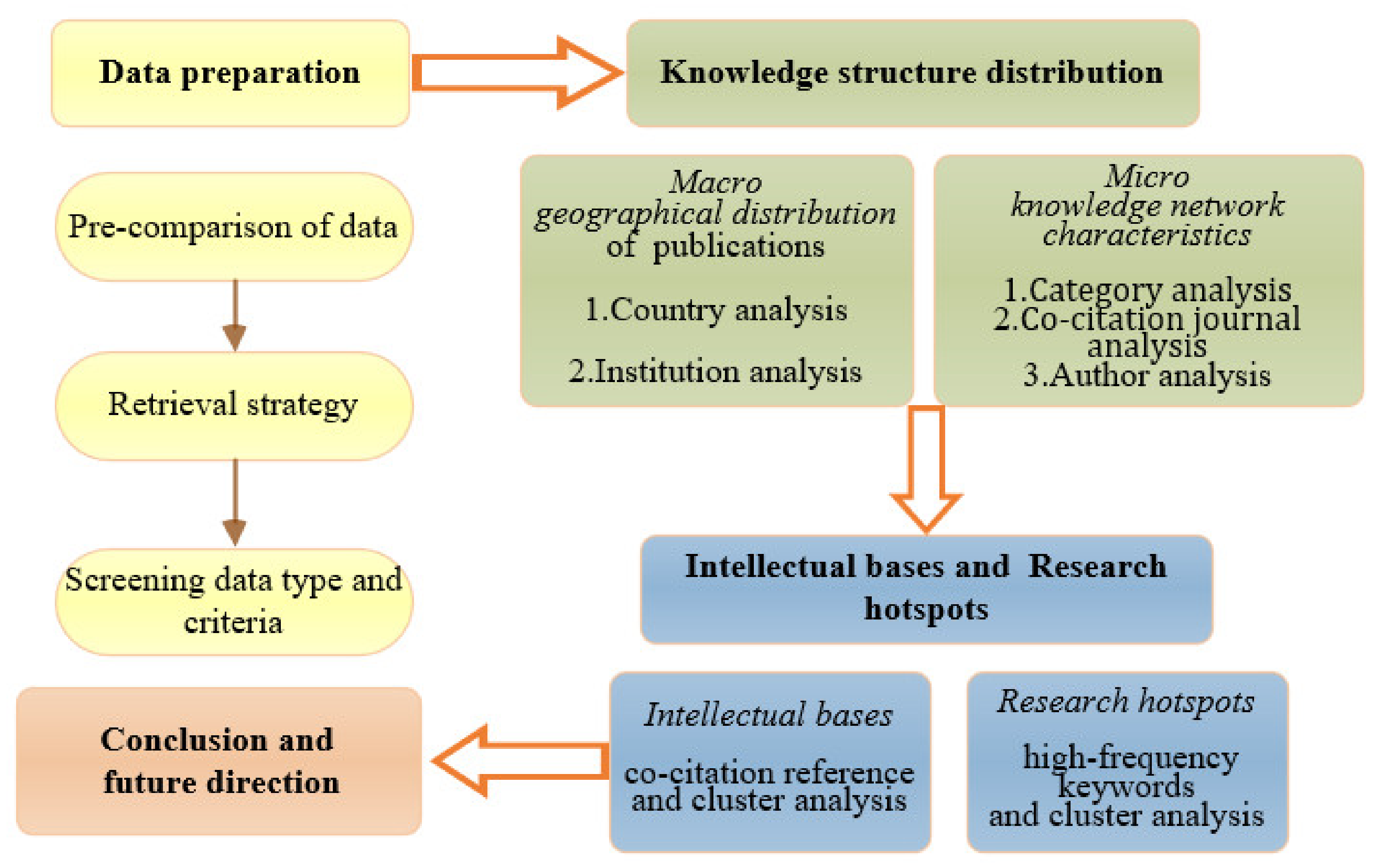
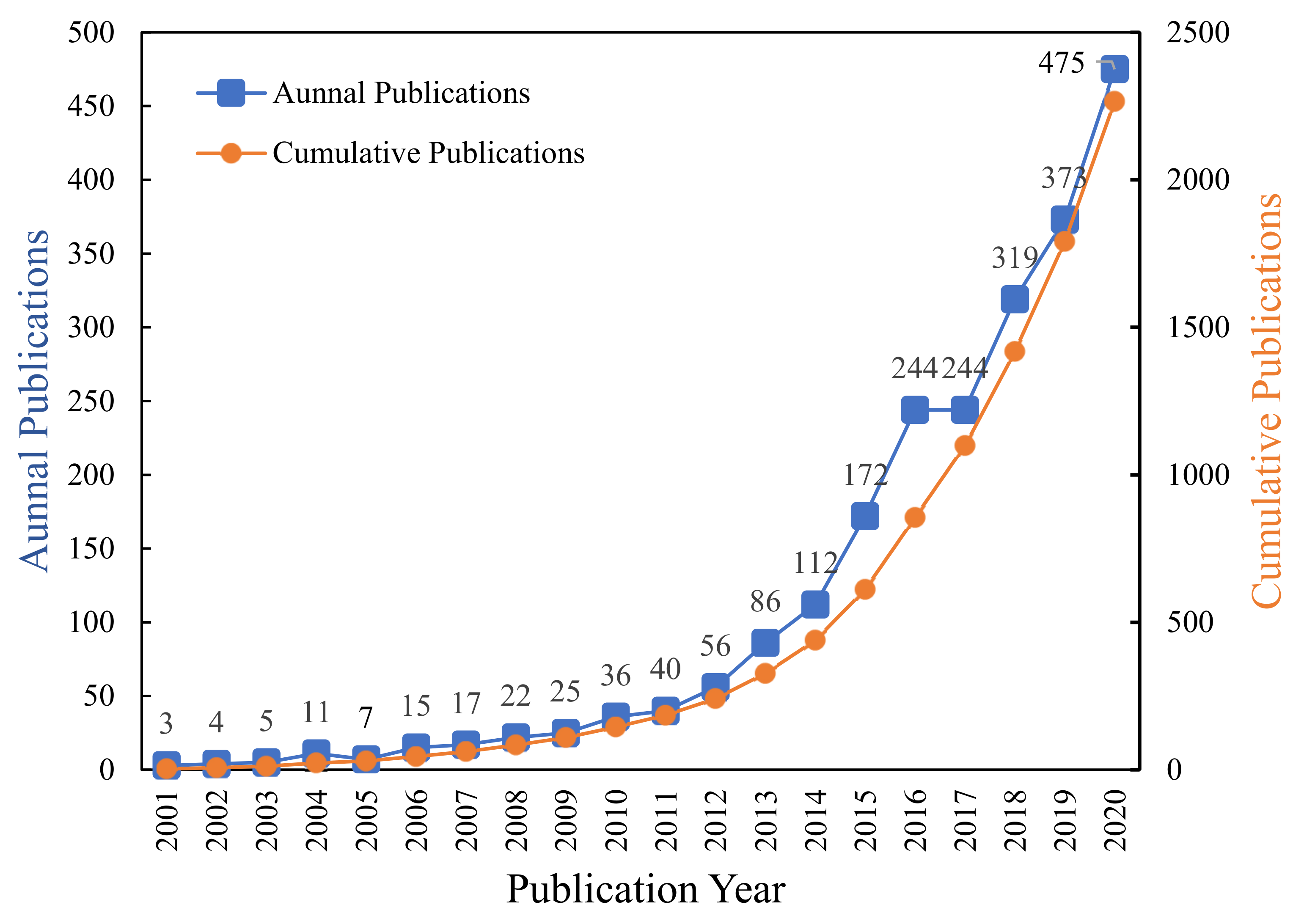

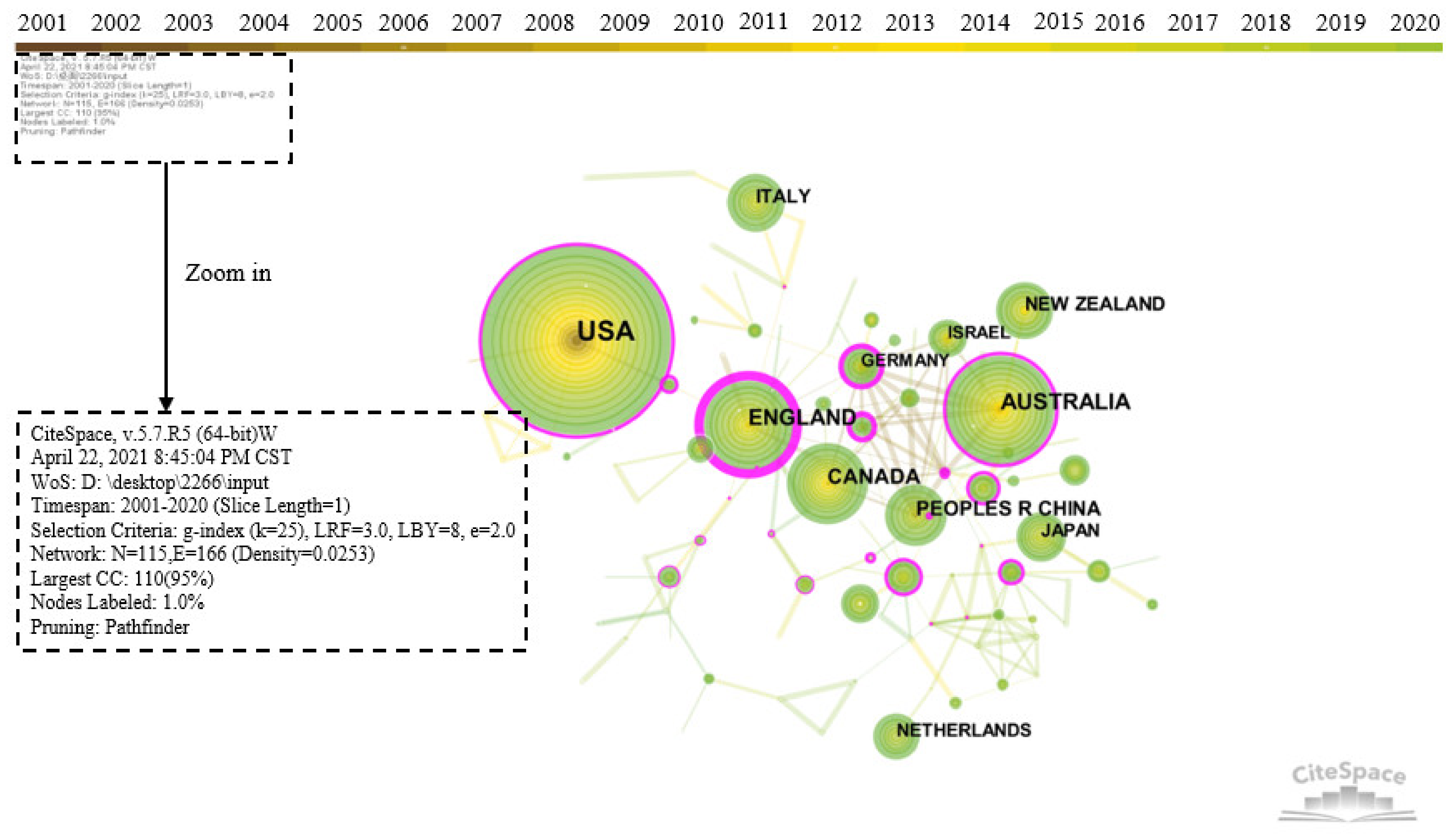
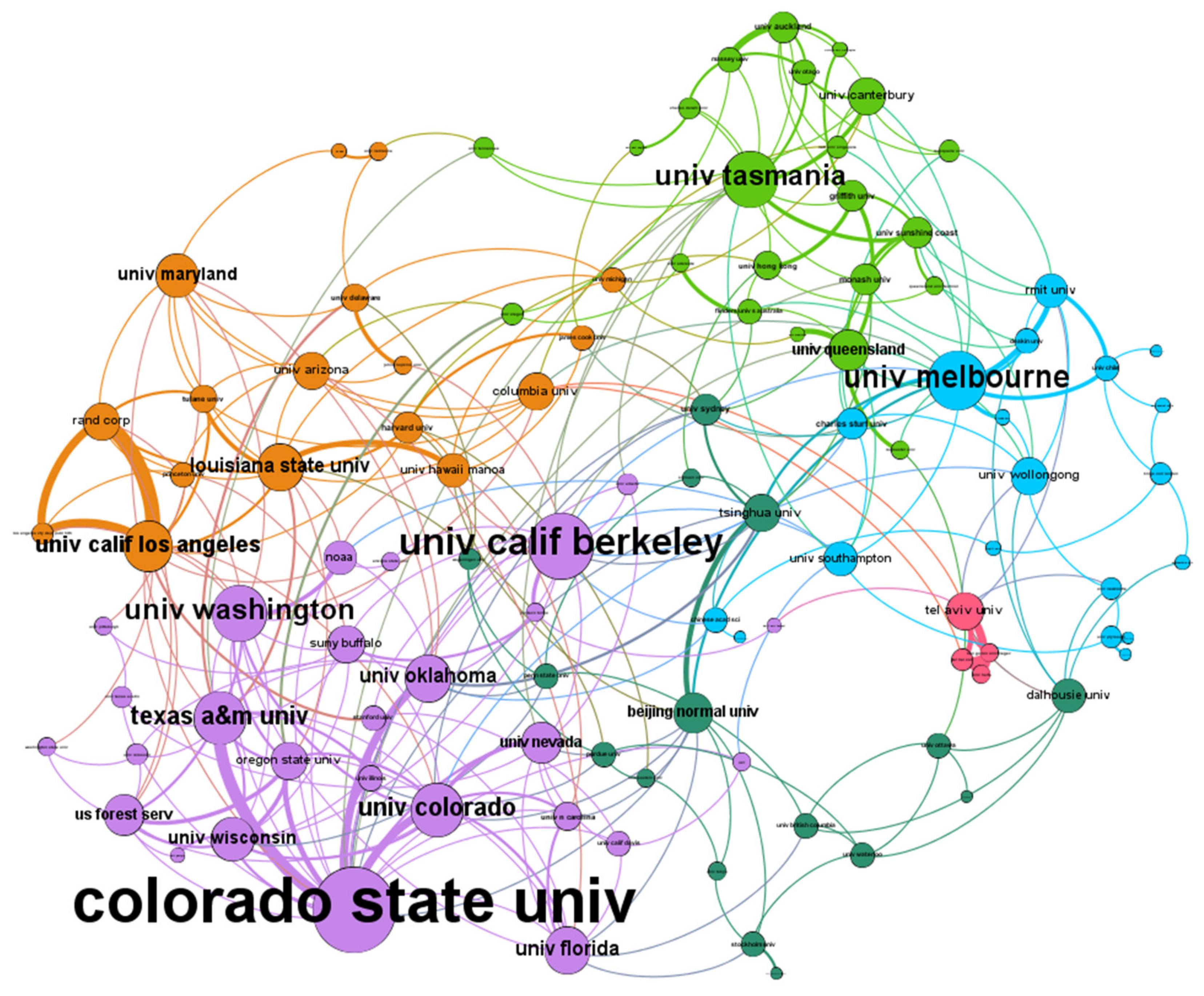
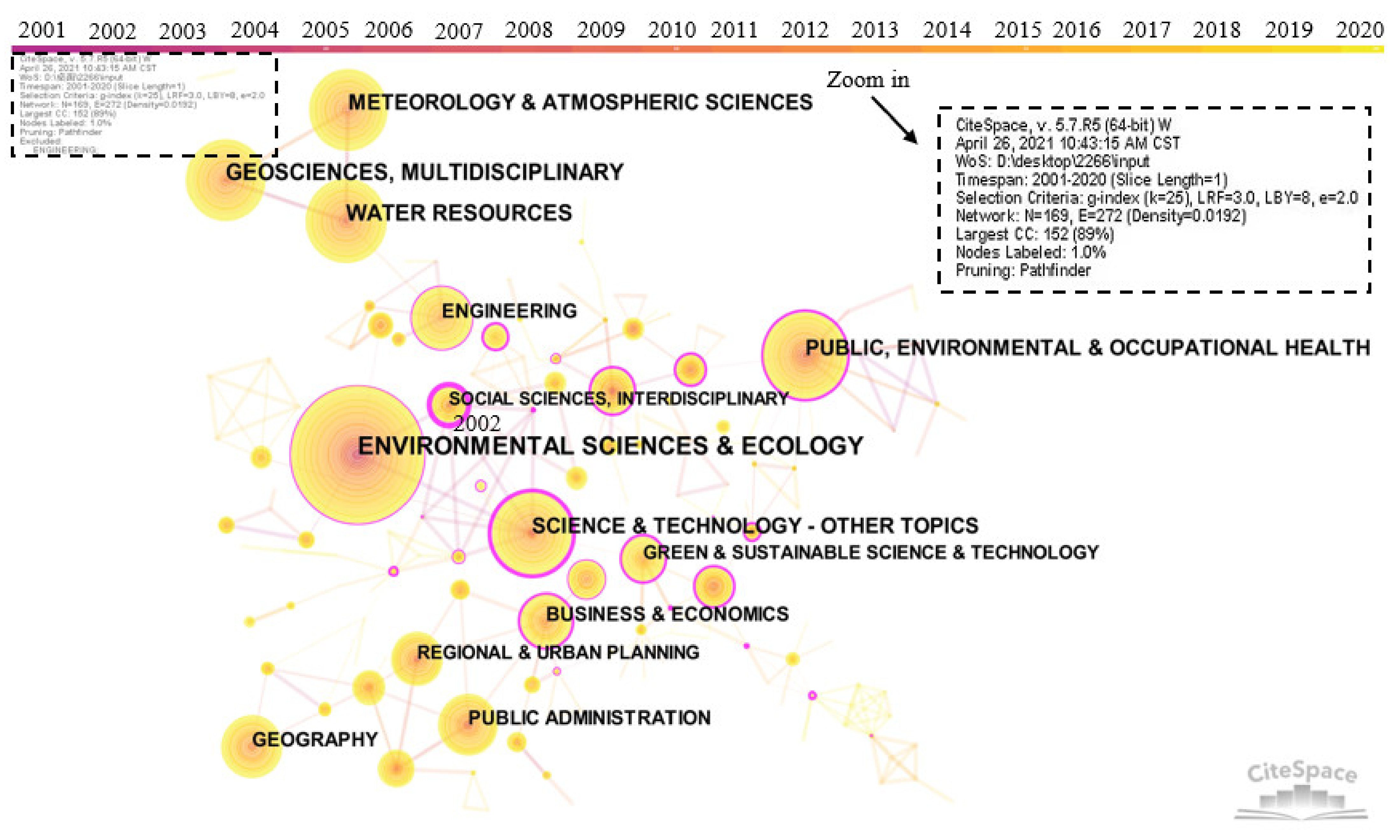
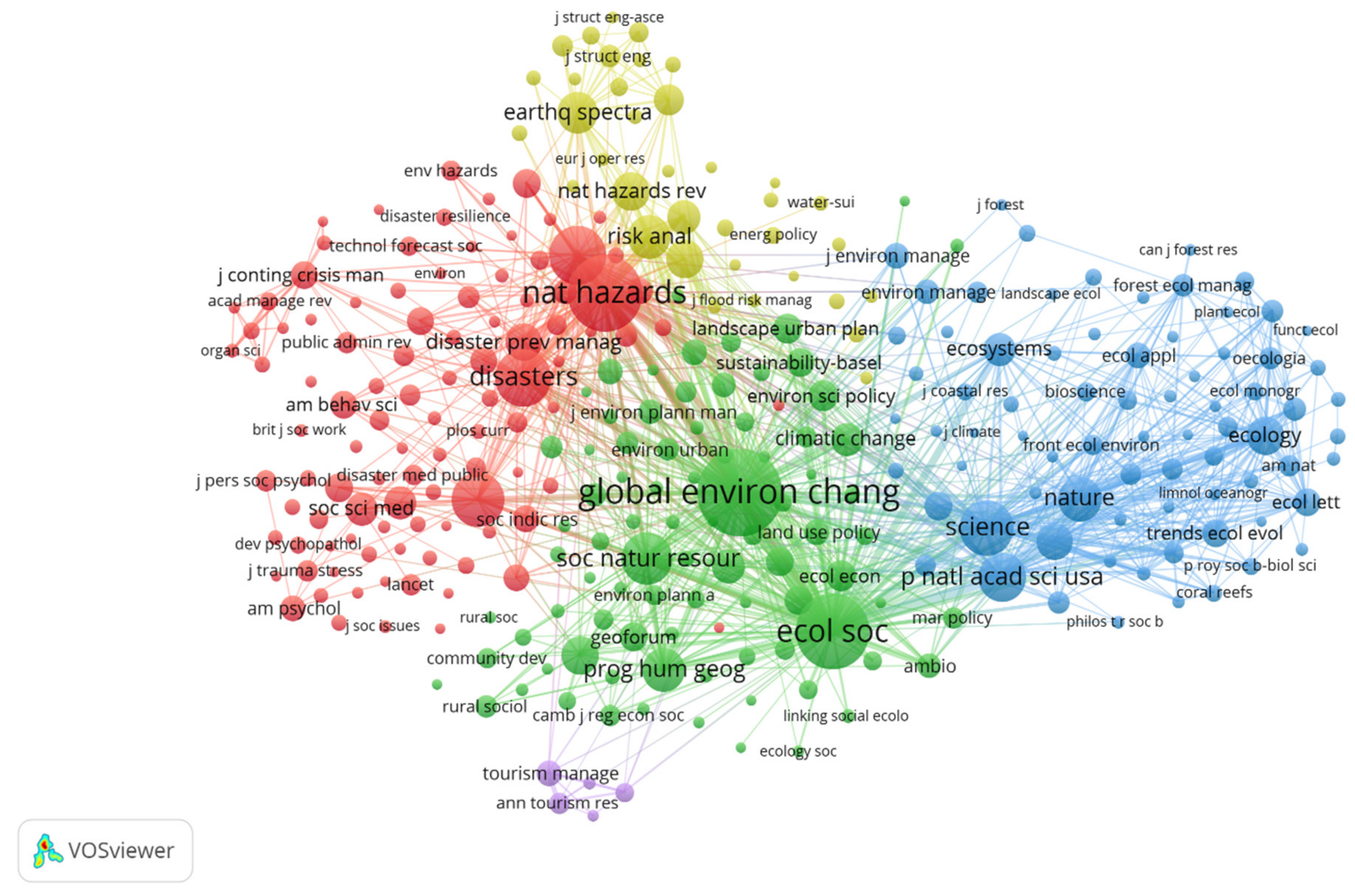
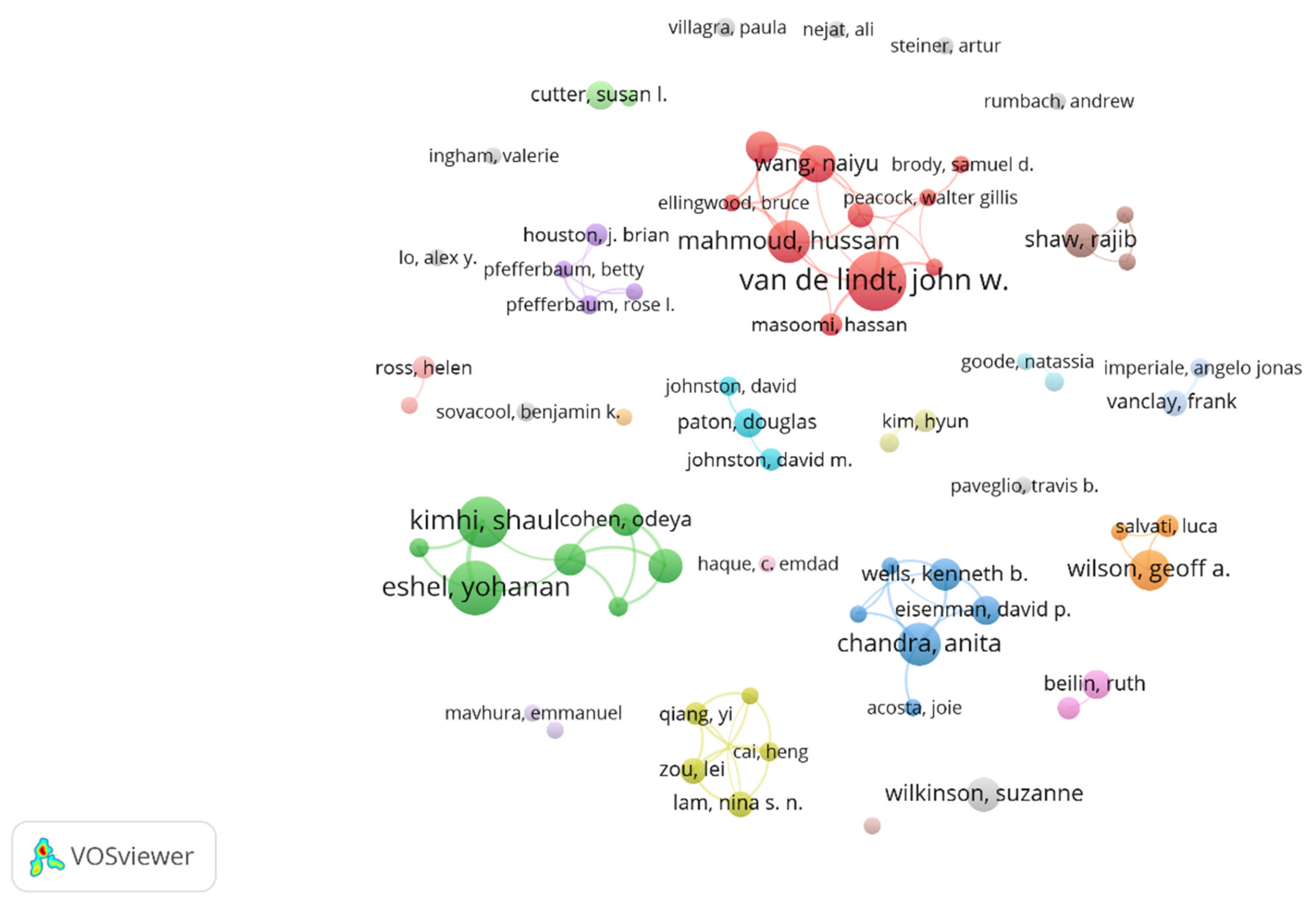
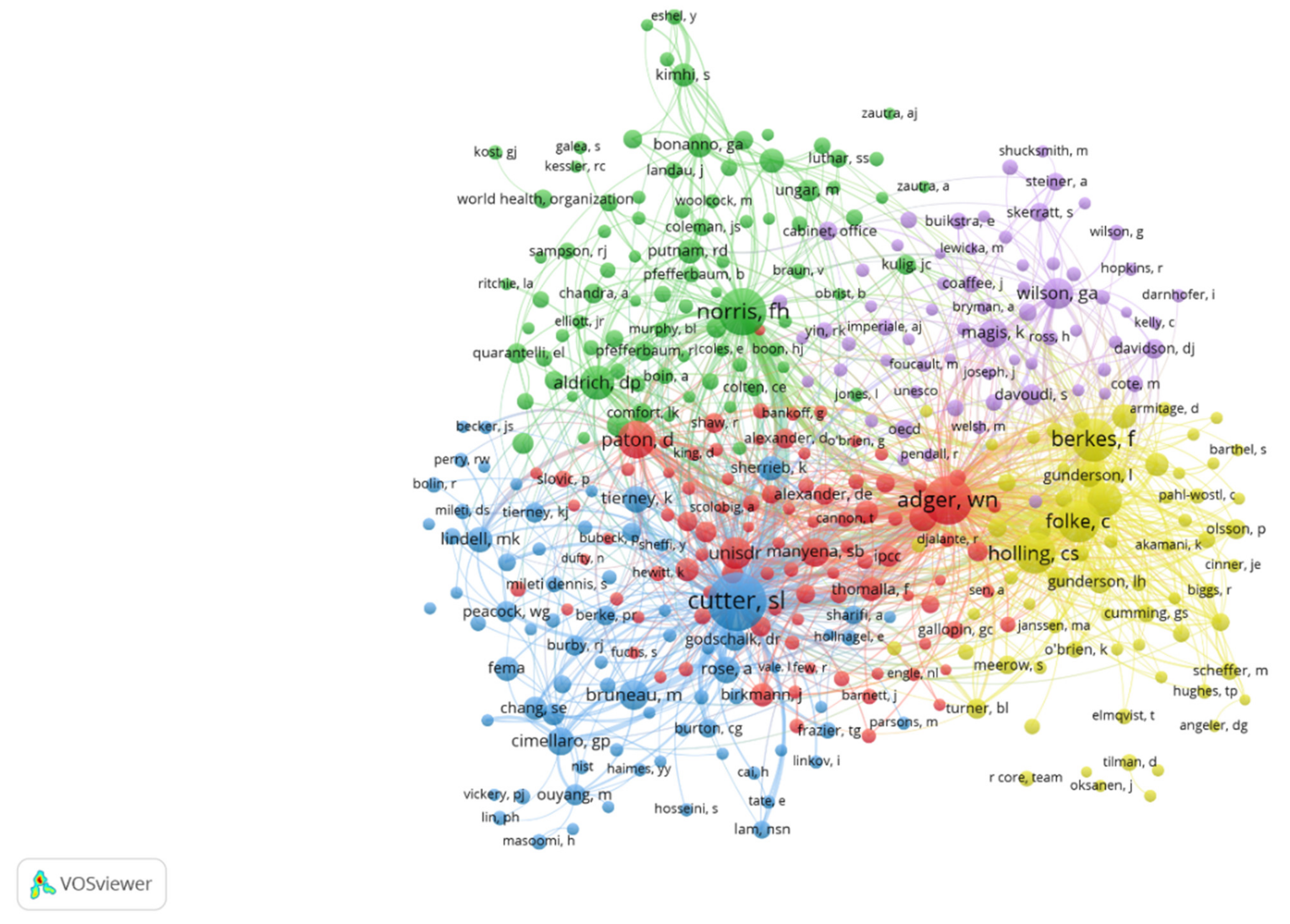
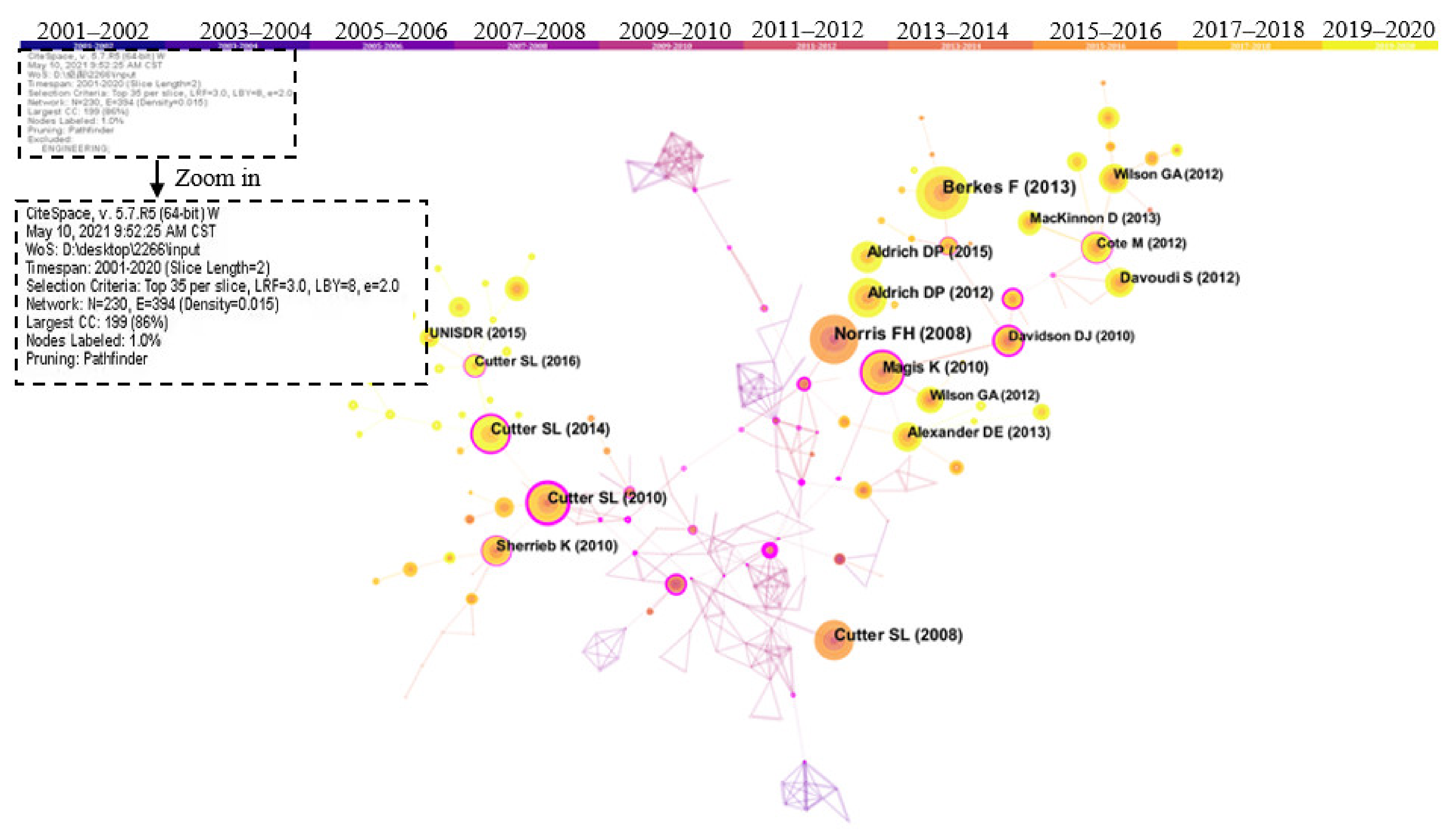
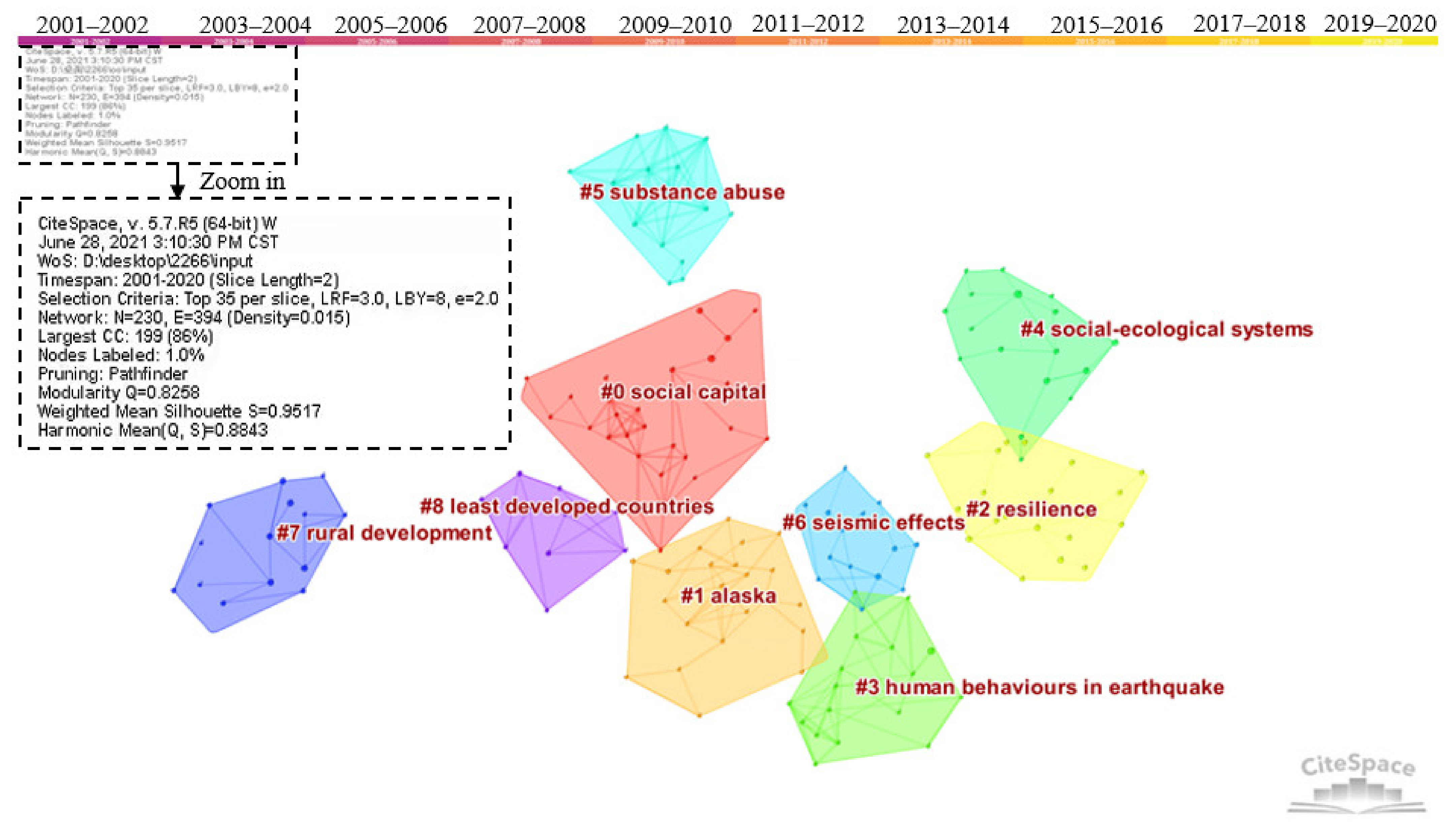
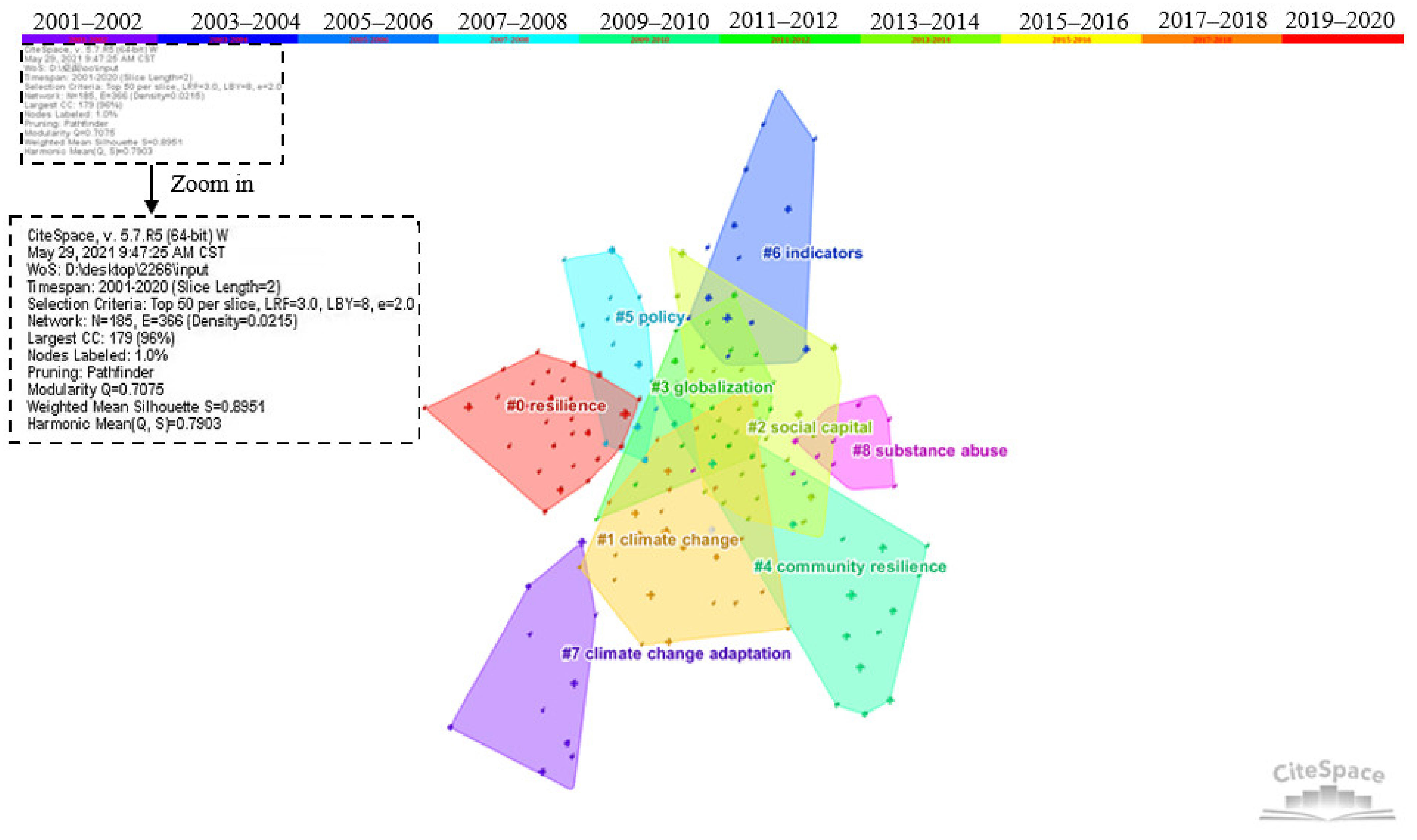
| Rank | Country | Publications | Percentage | Centrality | TC | TC/P | Starting Year |
|---|---|---|---|---|---|---|---|
| 1 | USA | 875 | 28.65% | 0.26 | 21,168 | 24.19 | 2001 |
| 2 | Australia | 287 | 9.40% | 0.32 | 4733 | 16.49 | 2003 |
| 3 | England | 207 | 6.78% | 0.94 | 4351 | 21.02 | 2002 |
| 4 | Canada | 150 | 4.91% | 0.07 | 3430 | 22.87 | 2003 |
| 5 | China | 135 | 4.42% | 0.08 | 1331 | 9.86 | 2004 |
| 6 | New Zealand | 101 | 3.31% | 0 | 1920 | 19.01 | 2001 |
| 7 | Italy | 95 | 3.11% | 0.07 | 1284 | 13.52 | 2011 |
| 8 | The Netherlands | 78 | 2.55% | 0 | 692 | 8.87 | 2010 |
| 9 | Japan | 74 | 2.42% | 0 | 857 | 11.58 | 2009 |
| 10 | Germany | 59 | 1.93% | 0.44 | 934 | 15.83 | 2004 |
| Rank | Institutions | Publications | Centrality | Starting Year | TC | TC/P |
|---|---|---|---|---|---|---|
| 1 | Colorado State University | 51 | 0.08 | 2008 | 745 | 14.61 |
| 2 | Texas A&M University | 38 | 0.22 | 2008 | 770 | 20.26 |
| 3 | The University of Queensland | 37 | 0.03 | 2007 | 1134 | 30.65 |
| 4 | Louisiana State University | 28 | 0.02 | 2008 | 920 | 32.86 |
| 5 | Oregon State University | 26 | 0 | 2009 | 253 | 9.73 |
| 6 | The University of Melbourne | 25 | 0.08 | 2009 | 310 | 12.40 |
| 7 | University of Washington | 25 | 0.23 | 2003 | 1689 | 67.56 |
| 8 | University of California Los Angeles | 24 | 0.11 | 2009 | 443 | 18.46 |
| 9 | RAND Corp | 23 | 0.02 | 2009 | 373 | 16.22 |
| 10 | Oklahoma State University | 23 | 0.09 | 2015 | 368 | 16.00 |
| Rank | Category | Publications | Centrality | Starting Year | TC | TC/P |
|---|---|---|---|---|---|---|
| 1 | Environmental Sciences and Ecology | 691 | 0.16 | 2001 | 13,792 | 19.96 |
| 2 | Water Resource | 328 | 0.04 | 2001 | 5149 | 15.70 |
| 3 | Geosciences, Multidisciplinary | 302 | 0 | 2001 | 4965 | 16.44 |
| 4 | Meteorology and Atmospheric Sciences | 293 | 0 | 2001 | 4842 | 16.53 |
| 5 | Science and Technology—Other topics | 290 | 0.45 | 2002 | 5655 | 19.50 |
| 6 | Public, Environmental and Occupational Health | 263 | 0.32 | 2001 | 3434 | 13.06 |
| 7 | Engineering | 193 | 0.18 | 2003 | 3973 | 20.59 |
| 8 | Geography | 150 | 0 | 2004 | 527 | 34.85 |
| 9 | Public Administration | 141 | 0.06 | 2002 | 3817 | 27.07 |
| 10 | Business & Economics | 136 | 0.26 | 2008 | 2024 | 14.88 |
| Rank | Journal | Citations | Total Link Strength | Host Country/Region |
|---|---|---|---|---|
| 1 | Global Environmental Change-Human and Policy Dimensions | 2257 | 82,562 | England |
| 2 | Natural Hazards | 1774 | 56,064 | USA |
| 3 | Ecology and Society | 1744 | 79,466 | Canada |
| 4 | International Journal of Disaster Risk Reduction | 1092 | 32,633 | The Netherlands |
| 5 | Disasters | 1063 | 32,229 | England |
| 6 | Science | 989 | 42,654 | USA |
| 7 | American Journal of Community Psychology | 944 | 24,572 | USA |
| 8 | Society Natural Resources | 861 | 29,194 | USA |
| 9 | Proceedings of the National Academy of Sciences of the United States of America | 777 | 36,047 | USA |
| 10 | Nature | 646 | 26,246 | England |
| Rank | Author | Publications | Starting Year | Institution | Country | H-Index |
|---|---|---|---|---|---|---|
| 1 | John W van de Lindt | 20 | 2016 | Colorado State University | USA | 28 |
| 2 | Shaul Kimhi | 14 | 2016 | Tel Hai Academy College | ISRAEL | 15 |
| 3 | Yohanan Eshel | 14 | 2016 | Tel Hai Academy College | ISRAEL | 11 |
| 4 | Hussam Mahmoud | 14 | 2018 | Colorado State University | USA | 13 |
| 5 | Naiyu Wang | 11 | 2016 | Zhejiang University | CHINA | 19 |
| 6 | Anita Chandra | 10 | 2012 | Cambridge Inst Therapeut Immunol & Infect Dis CIT | ENGLAND | 22 |
| 7 | Peihui Lin | 10 | 2016 | Zhejiang University | CHINA | 8 |
| 8 | Suzanne Wilkinson | 9 | 2016 | Massey University | NEW ZEALAND | 17 |
| 9 | Bruce R Ellingwood | 8 | 2016 | Colorado State University | USA | 49 |
| 10 | Mooli Lahad | 8 | 2013 | Tel Hai Academy College | ISRAEL | 10 |
| Rank | Cited Author | Frequency | Centrality | Starting Year | Institution | H-Index |
|---|---|---|---|---|---|---|
| 1 | Cutter SL | 658 | 0.06 | 2008 | University of South Carolina System | 41 |
| 2 | Norris FH | 640 | 0.06 | 2008 | Dartmouth College | 64 |
| 3 | Adger WN | 507 | 0.25 | 2002 | University of Exeter | 60 |
| 4 | Folke C | 381 | 0.11 | 2008 | Stockholm University | 94 |
| 5 | Berkes F | 375 | 0.08 | 2006 | University of Manitoba | 46 |
| 6 | Holling CS | 350 | 0.11 | 2008 | University of Florida | 37 |
| 7 | Paton D | 262 | 0.14 | 2007 | University of Canberra | 32 |
| 8 | Walker B | 254 | 0.1 | 2008 | Australian National University | 58 |
| 9 | Bruneau M | 215 | 0.07 | 2010 | State University of New York (SUNY) System | 33 |
| 10 | Aldrich DP | 212 | 0.01 | 2012 | Northeastern University | 14 |
| Rank | Title | Cited Frequency | Author | Centrality | Document Type | Year |
|---|---|---|---|---|---|---|
| 1 | Community Resilience as a Metaphor, Theory, Set of Capacities, and Strategy for Disaster Readiness | 244 | Norris, FH; Stevens, SP; Pfefferbaum, B; Wyche, KF; Pfefferbaum, RL | 0.05 | Review | 2008 |
| 2 | Community Resilience: Toward an Integrated Approach | 217 | Berkes, F; Ross, H | 0.02 | Article | 2013 |
| 3 | A place-based model for understanding community resilience to natural disasters | 164 | Cutter, SL; Barnes, L; Berry, M; Burton, C; Evans, E; Tate, E; Webb, J | 0 | Article | 2008 |
| 4 | Community Resilience: An Indicator of Social Sustainability | 127 | Magis K | 0.31 | Article | 2010 |
| 5 | Building Resilience: Social capital in post-disaster recovery | 125 | Aldrich DP | 0.04 | Book | 2012 |
| 6 | The geographies of community disaster resilience | 121 | Cutter, SL; Ash, KD; Emrich, CT | 0.21 | Article | 2014 |
| 7 | Social Capital and Community Resilience | 108 | Aldrich, DP; Meyer, MA | 0 | Article | 2015 |
| 8 | Disaster Resilience Indicators for Benchmarking Baseline Conditions | 108 | Cutter, SL; Burton, CG; Emrich, CT | 0.46 | Article | 2010 |
| 9 | Resilience and disaster risk reduction: an etymological journey | 80 | Alexander, DE | 0.02 | Article | 2013 |
| 10 | Measuring Capacities for Community Resilience | 79 | Sherrieb, K; Norris, FH; Galea, S | 0.28 | Article | 2010 |
| Rank | Keywords | Frequency | Centrality | Rank | Keywords | Frequency | Centrality |
|---|---|---|---|---|---|---|---|
| 1 | Community resilience | 976 | 0.16 | 16 | Sustainability | 108 | 0.11 |
| 2 | Resilience | 658 | 0.15 | 17 | Hazard | 99 | 0.01 |
| 3 | Vulnerability | 338 | 0.13 | 18 | Disaster resilience | 97 | 0.17 |
| 4 | Climate change | 326 | 0.12 | 19 | Preparedness | 96 | 0.06 |
| 5 | Disaster | 313 | 0.02 | 20 | Earthquake | 95 | 0.04 |
| 6 | Framework | 247 | 0.04 | 21 | Governance | 90 | 0 |
| 7 | Adaptation | 239 | 0.14 | 22 | Capacity | 90 | 0 |
| 8 | Risk | 219 | 0.06 | 23 | Perception | 89 | 0 |
| 9 | Management | 210 | 0.12 | 24 | Adaptive capacity | 82 | 0.1 |
| 10 | Community | 151 | 0.06 | 25 | Perspective | 80 | 0.07 |
| 11 | Recovery | 150 | 0.02 | 26 | Indicator | 80 | 0.18 |
| 12 | Model | 150 | 0 | 27 | Social vulnerability | 79 | 0 |
| 13 | System | 142 | 0.06 | 28 | Natural disaster | 76 | 0 |
| 14 | Impact | 136 | 0.2 | 29 | Policy | 75 | 0 |
| 15 | Health | 119 | 0.21 | 30 | Strategy | 66 | 0.14 |
Publisher’s Note: MDPI stays neutral with regard to jurisdictional claims in published maps and institutional affiliations. |
© 2021 by the authors. Licensee MDPI, Basel, Switzerland. This article is an open access article distributed under the terms and conditions of the Creative Commons Attribution (CC BY) license (https://creativecommons.org/licenses/by/4.0/).
Share and Cite
Yang, Q.; Yang, D.; Li, P.; Liang, S.; Zhang, Z. A Bibliometric and Visual Analysis of Global Community Resilience Research. Int. J. Environ. Res. Public Health 2021, 18, 10857. https://doi.org/10.3390/ijerph182010857
Yang Q, Yang D, Li P, Liang S, Zhang Z. A Bibliometric and Visual Analysis of Global Community Resilience Research. International Journal of Environmental Research and Public Health. 2021; 18(20):10857. https://doi.org/10.3390/ijerph182010857
Chicago/Turabian StyleYang, Qiaoyun, Dan Yang, Peng Li, Shilu Liang, and Zhenghu Zhang. 2021. "A Bibliometric and Visual Analysis of Global Community Resilience Research" International Journal of Environmental Research and Public Health 18, no. 20: 10857. https://doi.org/10.3390/ijerph182010857
APA StyleYang, Q., Yang, D., Li, P., Liang, S., & Zhang, Z. (2021). A Bibliometric and Visual Analysis of Global Community Resilience Research. International Journal of Environmental Research and Public Health, 18(20), 10857. https://doi.org/10.3390/ijerph182010857





